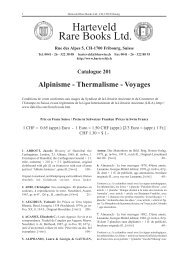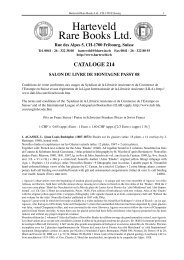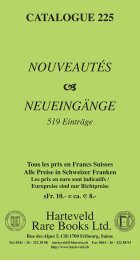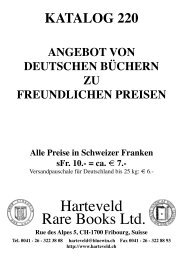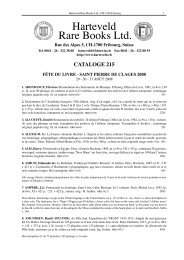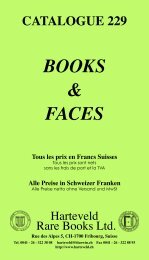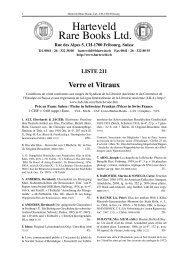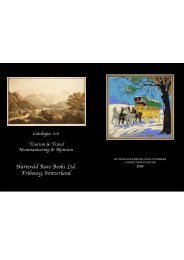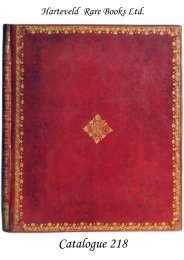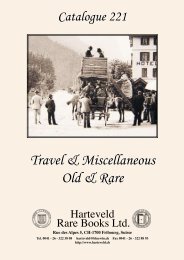Catalogue 217: CHF 20. - Harteveld Rare Books Ltd.
Catalogue 217: CHF 20. - Harteveld Rare Books Ltd.
Catalogue 217: CHF 20. - Harteveld Rare Books Ltd.
You also want an ePaper? Increase the reach of your titles
YUMPU automatically turns print PDFs into web optimized ePapers that Google loves.
114 <strong>Harteveld</strong> <strong>Rare</strong> <strong>Books</strong> <strong>Ltd</strong>., CH-1700 Fribourg<br />
schrift auf schwarzem Grund u. dunkelblauer/schwarzer<br />
Umrandung, davon 3 Blätter illuminiert (Deckblatt mit 3<br />
verschiedenfarbenen Seidenvorhängen zeigt in der Mitte<br />
Shakyamuni, Blatt 2 Subhuti, Blatt 3 einen Stupa), guter<br />
Zustand. HRB 83817 7500.-<br />
Eines der wichtigsten Sutren des Mahayna-Buddhismus, hier in<br />
tibetanischer Sprache und in einer wertvollen alten Handschrift<br />
überliefert. Der Diamant (vajra) durchschneidet (cchadika)<br />
Unwissenheit, Wahn und Illusion, welche Leid verursachen,<br />
und führt zur vollkommenen Weisheit des transzendentalen<br />
Verstehens (Prajnaparamita). Das Diamant-Sutra ist ein Dialog<br />
zwischen Buddha und seinem Schüler Subhuti (tib. Rabyor),<br />
welcher um Erklärungen zu einigen Punkten der Lehre bittet.<br />
Der Text ist eine Zusammenfassung der grundlegenden Lehren<br />
des Prajnaparamita, welches im 9. Jh. ins Tibetanische übersetzt<br />
wurde und 12 Bände umfasst. Damit war dieses Sutra<br />
eine eigentliche Kurzanleitung, um das Nirvana zu erreichen<br />
und die Lehren Buddhas zu verinnerlichen, und es galt als verdienstvoll,<br />
dieses zu lesen und zu rezitieren. Dementsprechend<br />
war es zu allen Zeiten ein wichtiger und vielgelesener Text.<br />
Unsere Handschrift ist ein besonders schön ausgeführtes Exemplar,<br />
welches leider nicht datiert ist. (Blatt n° 15 fehlt). Mit<br />
einer Expertise von F.A. Peters.<br />
Beautiful manuscript in gilt letters in Tibetan language of one<br />
of the most important sutras of Mahayna buddhism. The Diamond<br />
Sutra, that cuts like a diamond through ignorance and<br />
illusion and leads to perfect wisdom is a summary of the essential<br />
teachings and was often read and recited. Undated, this<br />
ms. dates very probably before 1800.<br />
Manuscrits éthiopiens<br />
Äthiopische Handschriften<br />
Most Ethiopian manuscripts are religious Christian texts of<br />
the Ethiopian Orthodox Church, one of the few early Christian<br />
churches of sub-Saharan Africa with traditions going back to<br />
the kingdom of Aksum (1st c. BC). The oldest known manuscripts<br />
date from the 10th century. These codices are written<br />
on parchment in Ge’ez, an ancient form of the Ethiopic language,<br />
which is still used by the Ethiopian Orthodox Church,<br />
and with the Ge’ez alphabet, a semitic script read from left to<br />
right. According to Christian Pankhurst the manuscripts cover<br />
a wide range of literature, including not only Bibles, religious<br />
service books, homilies, Biblical commentaries, and works on<br />
theology, but also writings on ecclesiastical and civil law, lives<br />
of saints, local as well as foreign, history, chronography and<br />
medicine. They could be for private use or belong to a church<br />
or monastery. Typically they are written in black and red ink<br />
(black for normal text, red for the name of God, Saints and the<br />
Holy Family etc.) and can be decorated with colorful illustrations.<br />
668. Mäzmurä Dawit (Psalms of David). Ethiopic<br />
manuscript on vellum in original leather bag. n.d. (18th<br />
c.), 16x17 cm (book) / 18x18 cm (bag), ca. 205 leaves on<br />
vellum, Ge’ez manuscript in black ink, with rubrics and<br />
titles in red. Sheet size 15.5 : 15.5 cm, 1 column, with<br />
smaller endpapers before and after the text, containing<br />
writing exercices and on the one at the end the begin<br />
of a magic prayer, slightly worn, beautiful full leather<br />
binding, richly blind tooled decorations on both covers<br />
and some on spine, inside covers covered with patterned<br />
cloth, in good condition, with orig. leather bag with lid,<br />
stitched together with leather cords and a leather band to<br />
hold it, lid with missing side, used. HRB 87932 2200.-<br />
Original manuscript of<br />
the Ethiopian Orthodox<br />
Church containing<br />
the Psalms of David<br />
written in the old liturgical<br />
language Ge’ez.<br />
Paleographically dated<br />
to the 18th c., possibly<br />
the first half of the<br />
century (in reference to<br />
the Gwelh script). The<br />
original leather bookbag<br />
for protection and transportation is made of rougher leather<br />
than the bindings and made to fit exactly this codex (based on<br />
the analysis by Dr. V. Six, Hamburg). Most Ethiopian manuscripts<br />
are religious Christian texts of the Ethiopian Orthodox<br />
Church, one of the few early Christian churches of sub-Saharan<br />
Africa with traditions going back to the kingdom of Aksum<br />
(1st c. BC). The oldest known manuscripts date from the 10th<br />
century. These codices are written on parchment in Ge’ez, an<br />
ancient form of the Ethiopic language, which is still used by<br />
the Ethiopian Orthodox Church, and with the Ge’ez alphabet,<br />
a semitic script read from left to right. According to Christian<br />
Pankhurst the manuscripts cover a wide range of literature, including<br />
not only Bibles, religious service books, homilies, Biblical<br />
commentaries, and works on theology, but also writings<br />
on ecclesiastical and civil law, lives of Saints, local as well as<br />
foreign history, chronography and medicine. They could be for<br />
private use or belong to a church or monastery. Typically they<br />
are written in black and red ink (black for normal text, red for<br />
the name of God, Saints and the Holy Family etc.) and can be<br />
decorated with colorful illustrations.<br />
669. Mäzmurä Dawit (Psalms of David). Ethiopic<br />
manuscript on vellum in original leather bag. n.d. (after<br />
�<br />
�



